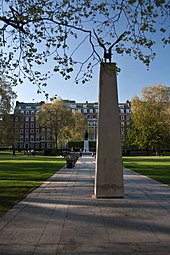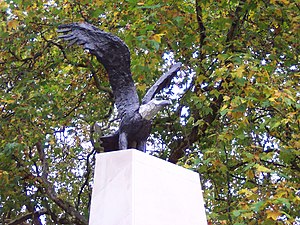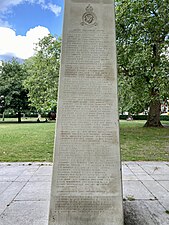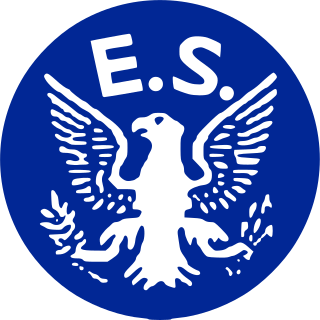
The Eagle Squadrons were three fighter squadrons of the Royal Air Force (RAF) formed with volunteer pilots from the United States during the early days of World War II, prior to America's entry into the war in December 1941.

133 Squadron RAF was one of the famous Eagle Squadrons formed from American volunteers serving with the Royal Air Force (RAF) during the Second World War.

The 4th Fighter Group was an American element of the United States Army Air Forces (USAAF) Eighth Air Force during World War II. The group was known as the Debden Eagles because it was created from the three Eagle Squadrons of the Royal Air Force: No. 71, No. 121 Squadron RAF, and No. 133 Squadron RAF. These squadrons became the 334th, 335th, and 336th Fighter Squadrons of the 4th Fighter Group based at RAF Debden. The group was the first fighter group to fly combat missions over German airspace, the first to escort bombers over Berlin, and the first selected to escort bombers on shuttle bombing runs landing in Russia. The group was credited with shooting down 1,016 German planes.
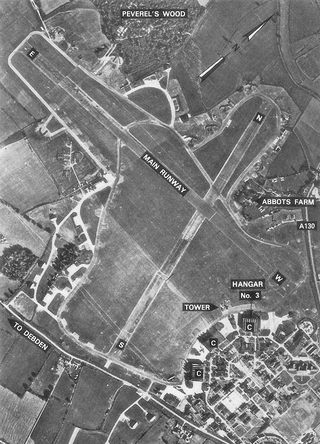
Royal Air Force Debden or more simply RAF Debden is a former Royal Air Force station located 3 miles (4.8 km) southeast of Saffron Walden and approximately 1 mile (1.6 km) north of the village of Debden in north Essex, England
The Royal Air Force (RAF) and Fleet Air Arm had included personnel from outside the United Kingdom from before the beginning of the Second World War, and many served in the Battle of Britain in summer 1940. Many of these volunteers were British subjects—thus, citizens—coming from territories that made up part of the British Empire. Additionally, a significant part was made up of refugees and exiles from German-occupied Europe and American emigrants.

The Polish Air Force Memorial is a war memorial in West London, England in memory of airmen from Poland who served in the Royal Air Force as part of the Polish contribution to World War II. Over 18,000 men and women served in the Polish squadrons of the RAF during the war, and over 2,000 died. The memorial marks the southern extremity of South Ruislip in the London Borough of Hillingdon, near RAF Northolt, where seven Polish-manned fighter squadrons were based at different times in the war.

Royal Air Force Martlesham Heath or more simply RAF Martlesham Heath is a former Royal Air Force station located 1.5 miles (2.4 km) southwest of Woodbridge, Suffolk, England. It was active between 1917 and 1963, and played an important role in the development of Airborne Interception radar.

No. 307 (Polish) Squadron, also known as No. 307 Squadron was one of several Polish squadrons during the Second World War. It was formed as part of an agreement between the Polish Government in Exile and the United Kingdom in 1940. It was the only Polish night fighter squadron in RAF service. No. 307 Squadron was named after the Polish city of Lwów, and was nicknamed "Eagle Owls".
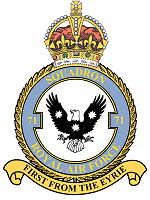
No. 71 Squadron was a Royal Air Force aircraft squadron. The number has been used three times: once by the Royal Flying Corps for an Australian Flying Corps squadron; in the Second World War as the first of three Eagle Squadrons; and post-war as a fighter-bomber unit under the command of Royal Air Force Germany.
Lieutenant Colonel William Robert "Poppy" Dunn was the first American flying ace of World War II. Joining the Canadian Army at the outbreak of war in 1939, he was an infantryman until he transferred to the Royal Air Force (RAF) in late 1940. After service in an RAF Eagle Squadron, he joined the United States Army Air Forces in 1943. Transferring to the newly established United States Air Force in 1947, he also participated in the Chinese Civil War, Cold War and the Vietnam War.
Royal Air Force Kirton in Lindsey or more simply RAF Kirton in Lindsey is a former Royal Air Force station located 15 miles (24 km) north of Lincoln, Lincolnshire, England.
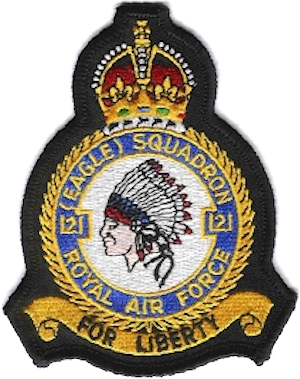
No. 121 Squadron was a Royal Air Force (RAF) aircraft squadron that during the Second World War was one of the three Eagle Squadrons manned by American volunteers. There is a Royal Air Force Air Cadets squadron, based in Nuneaton, which shares its number.
Arthur Gerald Donahue, was an American fighter pilot who volunteered to fly for the British Royal Air Force in World War II. He was one of 11 American pilots who flew with RAF Fighter Command between 10 July and 31 October 1940, thereby qualifying for the Battle of Britain clasp to the 1939–45 campaign star. He was killed in action in September 1942.

Flying Officer Eugene Quimby "Red" Tobin was an American pilot who flew with the Royal Air Force during the Battle of Britain in World War II. He was one of 11 American pilots who flew with RAF Fighter Command between 10 July and 31 October 1940, thereby qualifying for the Battle of Britain clasp to the 1939–45 campaign star.

Flight lieutenant Andrew Beck Mamedoff, known as Andy, was an American pilot who flew with the Royal Air Force during the Battle of Britain in World War II. He was one of 11 American pilots who flew with RAF Fighter Command between 10 July and 31 October 1940, thereby qualifying for the Battle of Britain clasp to the 1939–45 campaign star.

Pilot Officer Vernon Charles "Shorty" Keough was an American pilot who flew with the Royal Air Force during the Battle of Britain in World War II. He was one of 11 American pilots who flew with RAF Fighter Command between 10 July and 31 October 1940, thereby qualifying for the Battle of Britain clasp to the 1939–45 campaign star.

Pilot Officer Phillip Howard Leckrone was an American pilot who flew with the Royal Air Force during the Battle of Britain in World War II. He was one of 11 American pilots who flew with RAF Fighter Command between 10 July and 31 October 1940, thereby qualifying for the Battle of Britain clasp to the 1939–45 campaign star. He was killed in a flying accident in January 1941.

Major General Carroll W. McColpin was a United States Air Force officer who served during World War II and the Cold War. Prior to the United States entry into World War II, in November 1940, he volunteered for duty with the Royal Air Force (RAF) in November 1940 and was commissioned a pilot officer in the RAF before transferring to the United States Army Air Forces in the grade of major in September 1942.
Richard Lear Alexander was an American World War II fighter ace who fought for the Allies in both the Royal Canadian Air Force and the United States Army Air Forces.

Charles Michael Sweeny was an American soldier of fortune, United States Army lieutenant colonel, French Foreign Legion officer, Polish army brigadier general, Royal Air Force (RAF) group captain, and journalist who fought in numerous conflicts in the 20th century. He recruited fellow Americans to fight in World War II prior to the United States entering the war.

